The other national road toll: Cars kill 10 million native animals each year
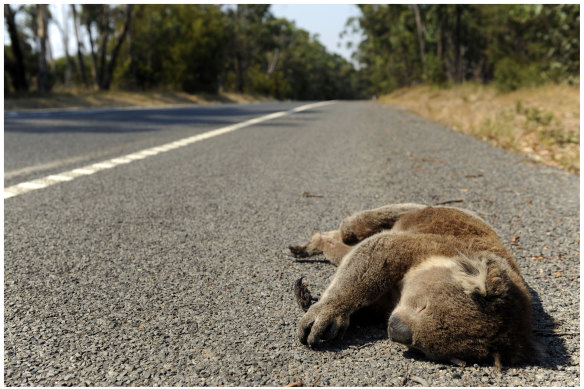
A dead koala in Gippsland, Victoria.Credit: Craig Abraham
Strolling around a golf course on the picturesque Great Ocean Road is not a bad way to spend an afternoon in the office.
But the team from the University of Melbourne was not there for a spot of golf. Rather, it was there to record the reactions of the colony of semi-tame eastern grey kangaroos to various sound recordings. Among the sounds: the distress call of birds including a magpie and a plover, the barking of a dog, and the sound of a human talking close by.
This took place last year, as part of a research and development project funded by Volkswagen that could eventually mean cars make noises in kangaroo hotspots to scare marsupials off the road. The so-called RooBadge is designed to fit into the VW badge, though the carmaker intends to make the technology available to other manufacturers as well.
Roadkill is a significant problem in Australia, for both humans and animals. Between 2018 and 2022, national figures show there were 36 fatal crashes caused by a vehicle hitting an animal.
The animals fare far worse. According to multiple peer-reviewed articles, 10 million native animals die on our roads each year. Research last decade involving citizen scientists breaks this down further: 4 million marsupials and 6 million birds, reptiles and other species.
The International Road Federation suggests there are more than 225,000 kilometres of roads in Australia. As Dr Colin Salter, research and policy officer at wildlife rescue group WIRES, says: “An overarching issue is that roads bisect habitat. More needs to be done to restore connectivity and enable the safer movement of wildlife across their range. This must be included in the planning stages for new roads, and in any road upgrades, as business as usual.”
Associate Professor Graeme Coulson, who is leading the RooBadge research, says the first phase of testing involved humans walking around the grounds of the Anglesea Golf Club manually playing sounds to kangaroos. The next phase involved mounting a device to a vehicle and driving it down the road towards sensors, to test how far the sound travelled.
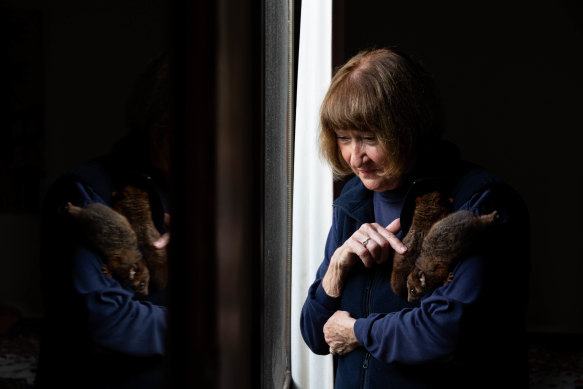
Wildlife rescue carer Glenda Clark nursing two baby possums whose mother was found dead.Credit: Janie Barrett
In about September, after some work on the technical side, the team will be testing with wild kangaroos. Coulson says the plan is to drive very slowly around the internal roads of some small parks and reserves known to have large kangaroo populations. Upon sighting a macropod, the driver will stop the car and play the sound.
If this proves successful and the animal retreats, that’s when things get real.
“The next test [after that] will be the harder one and that is driving the vehicle at reasonable speed,” Coulson says. “Speed will be one of the things we want to test through areas that have kangaroos present, so we’ll need to find suitable places for that and get all the approvals because it places both kangaroos and the driver at risk.”
The team will be looking for a suitable reaction – the kangaroo needs to actually get off the road, not just stand there listening to the strange noises. They also need to test things like how much can be heard in the cabin or by other road users.
The ultimate goal is to have an effective warning system for kangaroos to get off the road. The noises would be played only where needed. This could be mapped to roadkill hotspots identified by WIRES, a partner on the project. It could also involve smart internet-enabled cars being able to sense a wildlife warning sign or receive information about kangaroos in the vicinity from other cars further down the road.
Nathan Johnson, national product manager of Volkswagen Commercial Vehicle, said his division had been involved in funding the project for about four years.
“It came from the realisation that collisions with kangaroos are so frequent and so frequently fatal,” Johnson says. “Our vehicles have the highest tech accident avoidance and collision mitigation measures, but so far no device or measure has been successful in addressing this Australian problem.”
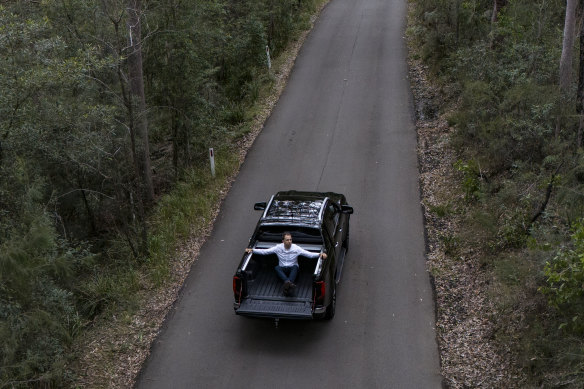
Nathan Johnson, national product manager of Volkswagen Commercial Vehicle. Volkswagen is funding the RooBadge research, but will make it available to other carmakers if successful.Credit: Sam Mooy
Johnson says if the RooBadge proves successful, the technology could be adapted to Europe and North America to prevent collisions with deer or moose.
Researching roadkill
Coulson became interested in roadkill in the 1970s when driving between Melbourne and his parents’ home along the Northern Highway that runs to the Murray River. One day, he noticed a yellow wildlife sign urging motorists to slow down. Coulson, counting the roadkill, found the sign had no effect on the quantity of dead animals on the road. His notes became the basis of what Coulson believes was the first peer-reviewed journal article on roadkill in Australia.
Coulson was part of a team (he credits Dr Helena Bender for doing most of the work) that assessed an earlier product designed to scare away kangaroos, the ShuRoo. Sold since 1986, the ShuRoo claims to emit a “unique pattern of high-frequency sound that is silent to humans but creates an extremely loud police siren type of alert to kangaroos”. The website says any kangaroo in the ShuRoo range of projection – about 400 metres in front of and 50 metres either side of a vehicle – would be alerted and scared away, but admits it’s not a “magical force field”.
Coulson says the device is marketed as “ultrasonic” but it emits a number of sounds that are clearly audible to humans. The researchers found kangaroos are not sensitive to the noises ShuRoo produces, the sounds are not detectable beyond 50 metres, and it could not be heard above the sound of the vehicle. Tests were done with fleets of vehicles traversing thousands of kilometres and there was no difference in wildlife collisions between the group with the ShuRoo and the control group.
ShuRoo managing director Justin Gore says its corporate fleet customers have done independent tests with good results.
“We have over the 30-odd years we’ve been doing this, had many, many doubters, as well as over 100,000 units sold throughout Australia with positive results,” Gore says.
“The vast majority of doubters either have never used the product or have had unrealistic expectations of what it can do. It’s impossible to be 100 per cent effective, 100 per cent of the time.”
Coulson says another device, a wind-activated whistle that can be attached to the front of vehicles, was similarly ineffective.
Kangaroos and wallabies are some of the most common roadkill because of their propensity to jump across roads, but cars are a serious problem for many other species as well, and multiple research projects are underway.
Koalas moving between trees
Koalas, endangered in NSW and Queensland, are vulnerable to being run over, especially during breeding season when they are most likely to be moving between trees.
Friends of the Koala says 71 animals were hit by vehicles in the Northern Rivers region of NSW between May 2023 and May 2024, and only 13 were able to be rehabilitated and released back to the wild.
Sydney’s koala population is under threat from housing development and increased traffic, especially around the south-western urban fringe.
The NSW government is providing $26 million to create koala-friendly crossings in south-west Sydney. Two will allow animals to cross below Appin Road, and a third will bridge a canal.
Professor Jun Zhou at Griffith University is working on a project to integrate artificial intelligence with road signs to reduce vehicle collisions. He says traditional, static wildlife warning signs have questionable effectiveness because “people see them every day and they get tired”. Instead, he’s hoping dynamic road signs could be updated with real-time information about koala movements.
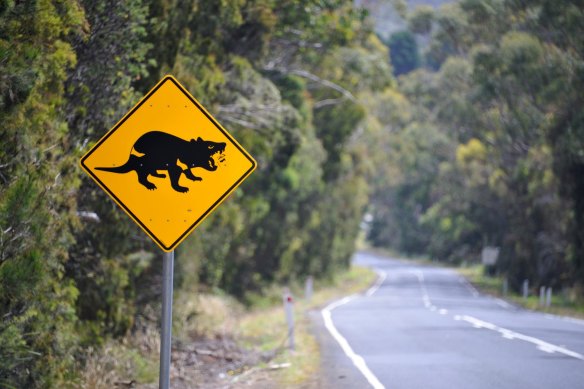
There are hopes static wildlife signs will be replaced by ones that update in real time to animals in their vicinity.Credit: imageBROKER / Alamy Stock Photo
The system integrates traditional koala tracking information like a collar or census information and sends signals to the road sign that could be updated with a message saying “a koala is nearby, please slow down”. His team has also added computer vision – a camera captures footage and AI detects a koala in it – as another layer.
Zhou says the first trial tested this in a zoo, the second on the university campus. “Currently, if the AI system is properly trained for the location where it’s going to be deployed, we can reach pretty high accuracy – like around 80 to 90 per cent – but if it’s moved to a new location, then we need to update the AI system again to teach it the new environment,” Zhou says.
Tassie Devils love a road restaurant
Samantha Fox, a wildlife biologist in the Tasmanian government’s Save the Tasmanian Devil program, says roadkill is the second-biggest threat to the marsupials, after facial tumour disease.
Radio tracking of devils in the wild shows they typically use the easiest course available, using tracks, dry riverbeds and roads to move around.
“They also use roads almost like a restaurant,” Fox says. “Because of roadkill of other species on the road, devils will, [as] they’re largely a scavenging species, find food on the road. So they’re drawn to roads for all sorts of reasons.”
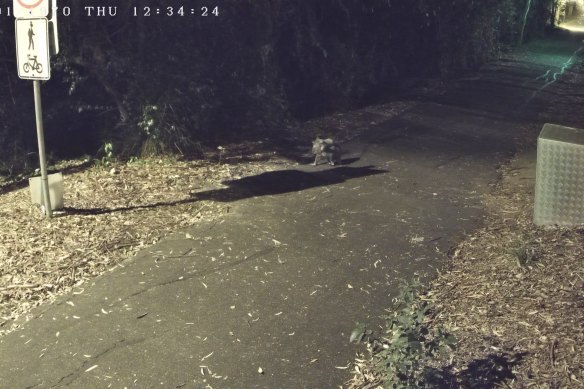
A koala caught on camera and identified by artificial intelligence as part of a Griffith University research project.
Fox says when a female devil dies, often her children die as well. The devils give birth in a pouch in about April, and move their babies to a den in about August when they grow too big. But those babies continue to be fed and supported by their mother until about January, and would starve without her.
In 2022, the government created an app for members of the public to report roadkill in the hope of better understanding where the hotspots are.
The program has trialled “virtual fencing” – car headlights will trigger flashing yellow and blue lights with a siren sound to warn animals away, and this will be set up every 25 metres on alternating sides of the road.
A government trial that ran for three years showed significant reduction in roadkill, but published studies that ran for shorter periods were less conclusive, Fox says. She adds that the devices need to be maintained and protected from vandalism, and work best where the community is already motivated to tackle the roadkill issue.
Separately, a three-year study on Phillip Island in south-east Victoria, found virtual fences were not effective for swamp wallabies, brush-tailed possums and ring-tailed possums.
Dr Christine Connelly at Victoria University says there is some evidence, mostly anecdotal, that animals just adapt to the strange noises.
“There’s the potential for habituation, so that’s when maybe a stimuli works in the beginning, but they might get used to it over time, like if you live in an area that has a train line rattling past every day … after a while you don’t notice it,” Connelly says.
“There were images of animals heading in the wrong direction, or just continuing to munch on the grass on this side of the road even when the devices are going off.”
Forested road crossings
Kylie Soanes, a wildlife biologist with the University of Melbourne, is an expert in wildlife crossings to link two sides of a busy road. This includes everything from underpasses, such as those being installed for koalas in Sydney, to dramatic forested bridges spanning the Pacific Motorway in northern NSW.
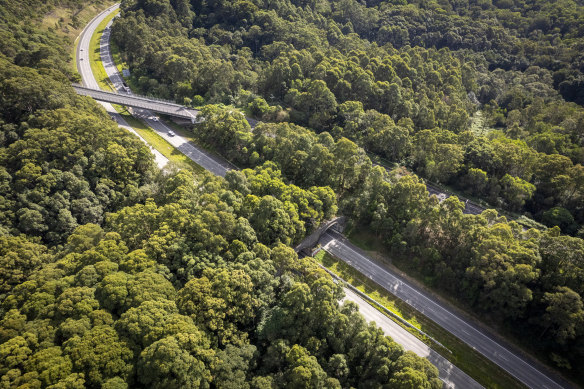
A forested overpass on the Pacific Highway in northern NSW, designed for all wildlife species to use.
But not all wildlife-crossing bridges need to be heavily engineered. For gliders and possums, a rope bridge at tree canopy level is enough.
Soanes says she was involved in a project to assess the value of canopy bridges for endangered gliders along the Hume Highway. It found that more squirrel gliders and possums crossed the road after they installed the bridges, and breeding pairs from opposite sides of the road were able to find each other for a rendezvous.
“We were concerned that maybe owls would use it as a bit of a sushi train and sit there all night to pick off animals as they cross,” Soanes says.
“In something like 14,000 crossings, we’ve only ever seen one owl attempt to take an animal that was crossing a bridge, and it failed because the bridge was designed to allow animals to escape those kinds of attacks by weaving through the bridge itself.
“You also have to consider that predators have to eat – one owl or one predator taking an animal is maybe not that big a deal compared to the hundreds that would have been killed by cars.”
Turtle breeding grounds
Turtles are long-lived, and one female can produce about 30 babies a year, so the loss of an individual can have a big impact on the ecosystem.
Associate Professor Ricky Spencer says turtles are drawn to roads both to cross and because they seek the highest point from wetlands to lay eggs.
Citizen science mapping tool TurtleSAT has identified hotspots for freshwater turtles dying on the roads, in what Spencer calls a “scary number”. He says colleagues in the computing department have added the next step by taking dashcam footage and using artificial intelligence to identify turtles.
One of the worst hotspots in Australia is western Sydney, near the new airport on The Northern Road. Fortunately, Spencer says, it’s easy to install barriers to stop turtles getting onto the road and to redirect them to the next creek or underpass.
“Normally, our roads have a meandering hill [the turtles] can climb up, but if you just put some cuttings down at the bottom they can’t actually climb up onto it,” Spencer says.
“[You don’t need] multi-million or billion-dollar overpasses, you can just redirect them to any culvert or creek.”
Spencer says Transport for NSW contacted his team to initiate trials and has retro-fitted barriers onto The Northern Road and Londonderry Road, and this will also form part of the design for the new M12 motorway.
Get to the heart of what’s happening with climate change and the environment. Sign up for our fortnightly Environment newsletter.